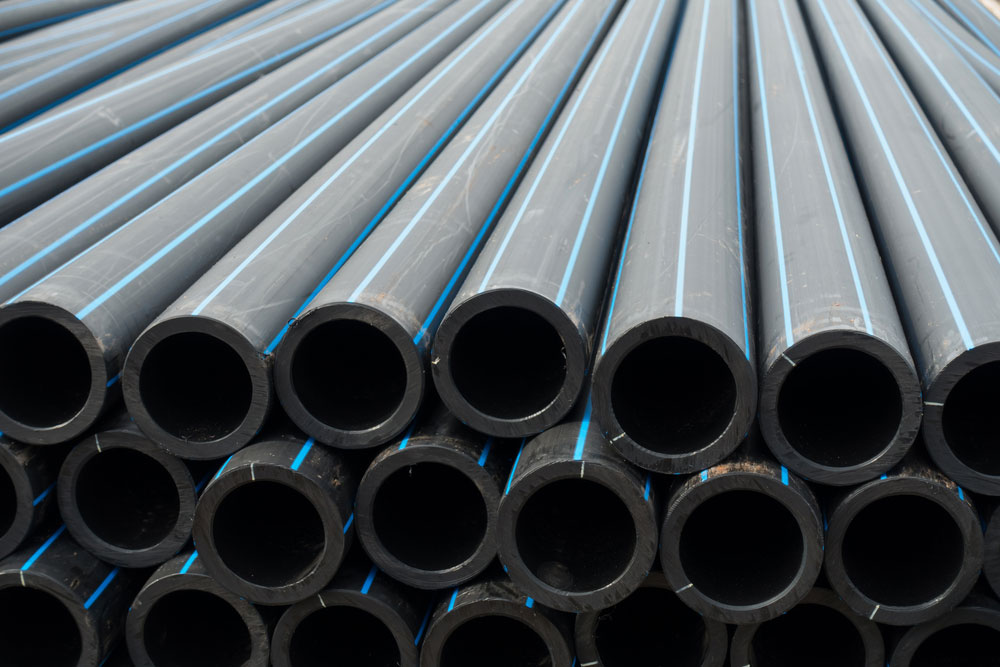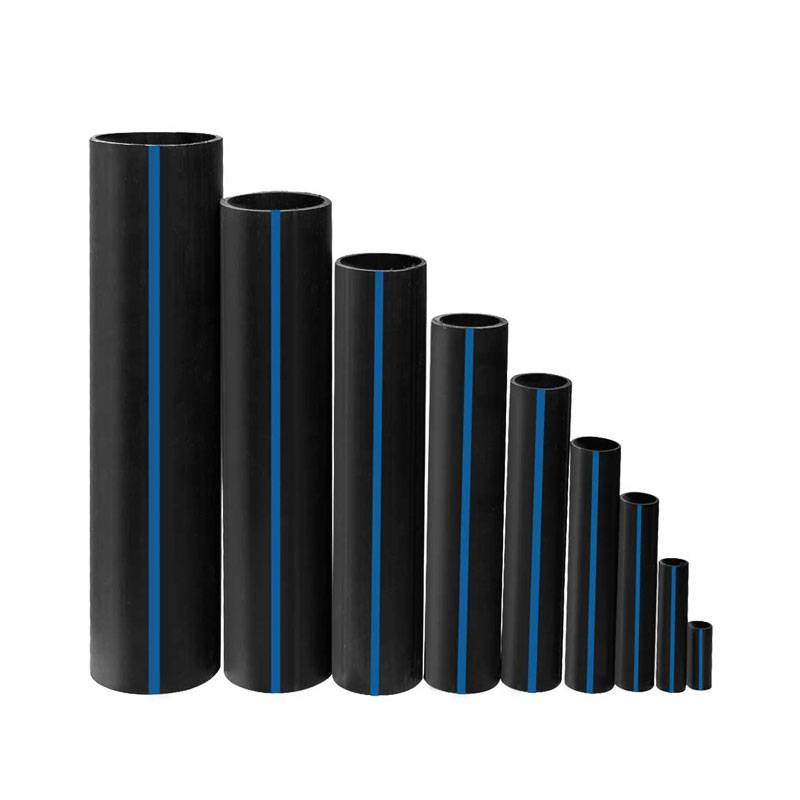Discover the Production Process Behind High-Quality HDPE Pipe and Its Applications
The manufacturing process of premium HDPE pipes is elaborate and methodical. It starts with the choice of raw materials that boost performance. Following this, ethylene goes through polymerization to develop resin, which is then formed with extrusion. Quality control is paramount, ensuring that the final item satisfies rigorous criteria. The journey of HDPE pipes doesn't end with manufacturing. Their applications across various sectors expose a more comprehensive relevance worth checking out.
Recognizing HDPE: Features and Advantages

High-density polyethylene (HDPE) is a functional thermoplastic known for its toughness and resistance to numerous environmental factors. This product shows superb tensile strength, making it suitable for requiring applications. Its low-density framework adds to a light-weight item, helping with ease of handling and installment. HDPE additionally showcases remarkable resistance to chemicals, which lessens deterioration when subjected to severe materials.
The material's reduced dampness absorption further boosts its durability, making it ideal for use in pipes and tank. Furthermore, HDPE is immune to ultraviolet (UV) radiation, guaranteeing that items keep their stability even when subjected to sunlight. Its flexibility permits for the creation of intricate forms without compromising stamina. The green nature of HDPE, commonly stemmed from recycled products, includes to its allure, advertising sustainable techniques in production. On the whole, these properties and advantages make HDPE a recommended choice for different commercial and consumer applications.
Resources Selection for HDPE Manufacturing
The choice of resources for HDPE manufacturing is necessary to confirm the final product meets the wanted specifications and quality criteria. High-density polyethylene (HDPE) is primarily generated from polymerized ethylene, stemmed from nonrenewable fuel sources such as natural gas or petroleum. The top quality of these feedstocks considerably affects the mechanical and thermal homes of the final HDPE.
Additives additionally play a substantial role in improving HDPE's performance, consisting of antioxidants, UV stabilizers, and colorants, which boost resilience and resistance to environmental aspects. The selection procedure must take into consideration not just the chemical structure of the raw products but also their processing characteristics to assure effective production.
The sourcing of raw materials need to prioritize sustainability and conformity with environmental laws, as accountable practices are important in today's market. Ultimately, careful basic material choice lays the structure for creating premium HDPE pipes suitable for diverse applications.
The Extrusion Refine: Forming HDPE Pipeline
The extrusion procedure plays a vital duty in forming HDPE pipelines, beginning with meticulous product prep work techniques that assure excellent circulation and consistency. Equally important is the design of the die, which straight affects the last measurements and surface high quality of the pipe. With each other, these factors add significantly to the efficiency and top quality of HDPE pipe production.
Product Prep Work Methods
Reliable manufacturing of HDPE pipes begins with careful material preparation methods, specifically the extrusion process. During this stage, high-density polyethylene resin is first dried out to get rid of wetness, making certain excellent circulation attributes. The resin is then fed into the extruder, where it undertakes heating and melting, transforming into a thick state. This home heating process is carefully managed to keep the material's integrity and performance. The liquified HDPE is compelled via a die, forming it right into a continuous pipe form. Appropriate temperature administration during extrusion is necessary, as it directly impacts the material's homes and the final product high quality. When formed, the HDPE pipe is cooled down and reduced to defined lengths, ready for subsequent processing and applications.
Die Design Value
Accuracy in die design plays an essential duty in the extrusion procedure of HDPE pipes. The die works as the final shaping device, straight affecting the pipe's measurements, wall surface density, and surface finish. A well-designed die guarantees consistent material flow, decreasing defects such as abnormalities and weak points. The geometry of the die should be optimized to fit the particular buildings of HDPE, including its thickness and thermal actions during extrusion. In addition, the cooling price of the product as it travels through the die can considerably influence the pipeline's architectural stability. As a result, investing in sophisticated die modern technology is essential for makers intending to generate premium HDPE pipes that meet industry criteria and customer expectations.
Quality Assurance Steps in HDPE Production
Although various variables influence the quality of HDPE pipe manufacturing, efficient top quality control procedures are crucial to guarantee consistency and integrity in the final item. Secret quality assurance methods include rigorous product inspection, validating that the raw polyethylene satisfies recognized criteria for purity and density. During the extrusion process, criteria such as temperature level, stress, and cooling time are closely kept an eye on to maintain dimensional precision and structural honesty
Additionally, post-production testing is crucial; producers often conduct hydrostatic examinations get more info to evaluate the pipeline's strength and resistance to pressure. Visual inspections for surface flaws additionally boost quality control. Certification from relevant standards organizations, like ASTM or ISO, gives an additional layer of trustworthiness. By executing these complete quality assurance procedures, suppliers can reduce issues, enhance performance, and make sure that the HDPE pipes satisfy the certain needs of various applications, inevitably causing customer complete satisfaction and count on in the item.
Applications of HDPE Pipe Across Industries
HDPE pipes are utilized across different markets due to their sturdiness and convenience. In water distribution systems, they assure effective delivery, while in wastewater administration, they supply reliable remedies for waste transport. Furthermore, farming irrigation networks benefit from HDPE's resistance to deterioration and adaptability, making it an optimal selection for modern-day farming methods.

Water Distribution Solutions
A significant number of industries rely upon high-density polyethylene (HDPE) pipelines for efficient water circulation systems. Known for their longevity and resistance to corrosion, HDPE pipes are extensively used in local water networks, agricultural watering, and commercial applications. Their lightweight nature promotes simple handling and installment, decreasing labor expenses and time. Additionally, HDPE pipes can accommodate numerous stress degrees, making them suitable for both reduced and high-pressure systems. custom hdpe pipe manufacturing Midland TX. The adaptability of the material enables seamless combination into existing infrastructure, lessening the demand for substantial excavation. Additionally, HDPE's resistance to chemical leaching warranties that the water supplied continues to be safe and clean, making it a perfect selection for keeping the high quality of potable water throughout different sectors
Wastewater Management Solutions
Effective water distribution systems likewise lead the means for innovative wastewater monitoring remedies, where high-density polyethylene (HDPE) pipelines play a substantial duty. Distinguished for their sturdiness and resistance to corrosion, HDPE pipes are excellent for transporting wastewater in numerous settings. Their adaptability allows for simple installation in complex settings, lessening the requirement for substantial excavation. In addition, HDPE's smooth indoor surface area reduces friction, boosting circulation rates and efficiency. These pipes are likewise resistant to chemical leaching, making certain that contaminants do not jeopardize the surrounding environment. Industries, towns, and therapy facilities increasingly depend on HDPE pipes for their dependability and longevity, making them a recommended choice for contemporary wastewater monitoring systems. This adaptability emphasizes the vital value of HDPE pipelines across many applications.
Agricultural Watering Networks
Agricultural irrigation networks benefit substantially from making use of high-density polyethylene (HDPE) pipelines, which give efficient and trustworthy water shipment to crops. HDPE pipes are lightweight, making them easy to deliver and install, while their versatility allows for various setups in diverse terrains. These pipelines show superb resistance to corrosion, chemicals, and UV radiation, ensuring toughness in rough agricultural atmospheres. Additionally, their smooth interior surface area decreases rubbing loss, enhancing water circulation and minimizing power expenses associated with pumping. The longevity of HDPE pipelines, usually going beyond 50 years, adds to decrease upkeep and replacement expenses. Subsequently, farmers increasingly count on HDPE pipes to enhance irrigation effectiveness and promote sustainable farming practices, inevitably bring about enhanced crop yields and source preservation.
Future Patterns in HDPE Pipe Modern Technology
As the demand for sustainable and reliable framework expands, improvements in HDPE pipeline innovation are positioned to transform various industries. Emerging fads include the combination of smart modern technologies, such as sensing units and IoT capacities, which facilitate real-time tracking of pipe problems, decreasing upkeep prices and protecting against leaks. Furthermore, the growth of innovative manufacturing strategies, such as 3D printing, is allowing the manufacturing of facility, personalized pipeline designs that satisfy certain task requirements.
Furthermore, the focus on recycling and circular economic climate methods is driving the development of HDPE pipes made from recycled materials, boosting sustainability. Improved jointing methods, such as electro-fusion and mechanical fittings, are likewise enhancing installment efficiency and dependability. Finally, the expanding emphasis on ecological guidelines is pressing manufacturers to take on greener manufacturing procedures, making sure that HDPE pipes not only fulfill industry criteria however additionally promote an even more sustainable future for facilities advancement.
Regularly Asked Inquiries
Exactly How Does HDPE Compare to Various Other Plastic Materials?
HDPE outmatches several other plastic materials concerning durability, chemical resistance, and adaptability. Its low density and high tensile toughness make it suitable for different applications, commonly surpassing alternatives in both performance and long life.
What Are the Environmental Effects of HDPE Production?
The ecological impacts of HDPE manufacturing consist of greenhouse gas discharges, energy consumption, and prospective pollution from manufacturing procedures. Furthermore, incorrect disposal can cause dirt and water contamination, elevating problems about long-lasting environmental results.
Can HDPE Piping Be Recycled?
Yes, HDPE pipes can be recycled. Many facilities accept used HDPE for processing, changing it right into brand-new products. This reusing contributes to sustainability efforts, decreasing plastic waste while saving sources and energy in the production cycle.
What Is the Lifespan of HDPE Pipeline?

How Do Temperature Variations Influence HDPE Pipe Performance?
Temperature level variants substantially impact HDPE pipeline efficiency, affecting adaptability and toughness. High temperature levels can result in softening, while reduced temperatures might trigger brittleness, eventually affecting the pipeline's toughness and suitability for numerous applications in diverse environments.